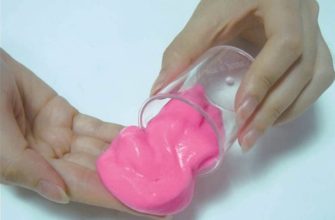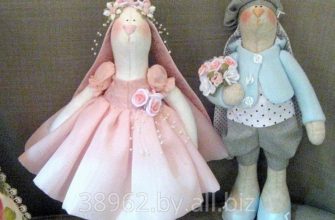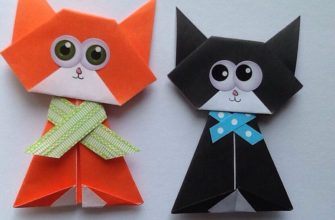Dolls are in every home where little girls and sometimes boys grow up. In ancient times, they were given a special meaning, believing that the toy could rejoice, laugh, be kind or evil. It could support the family in difficult times.
The meaning of the Russian rag doll
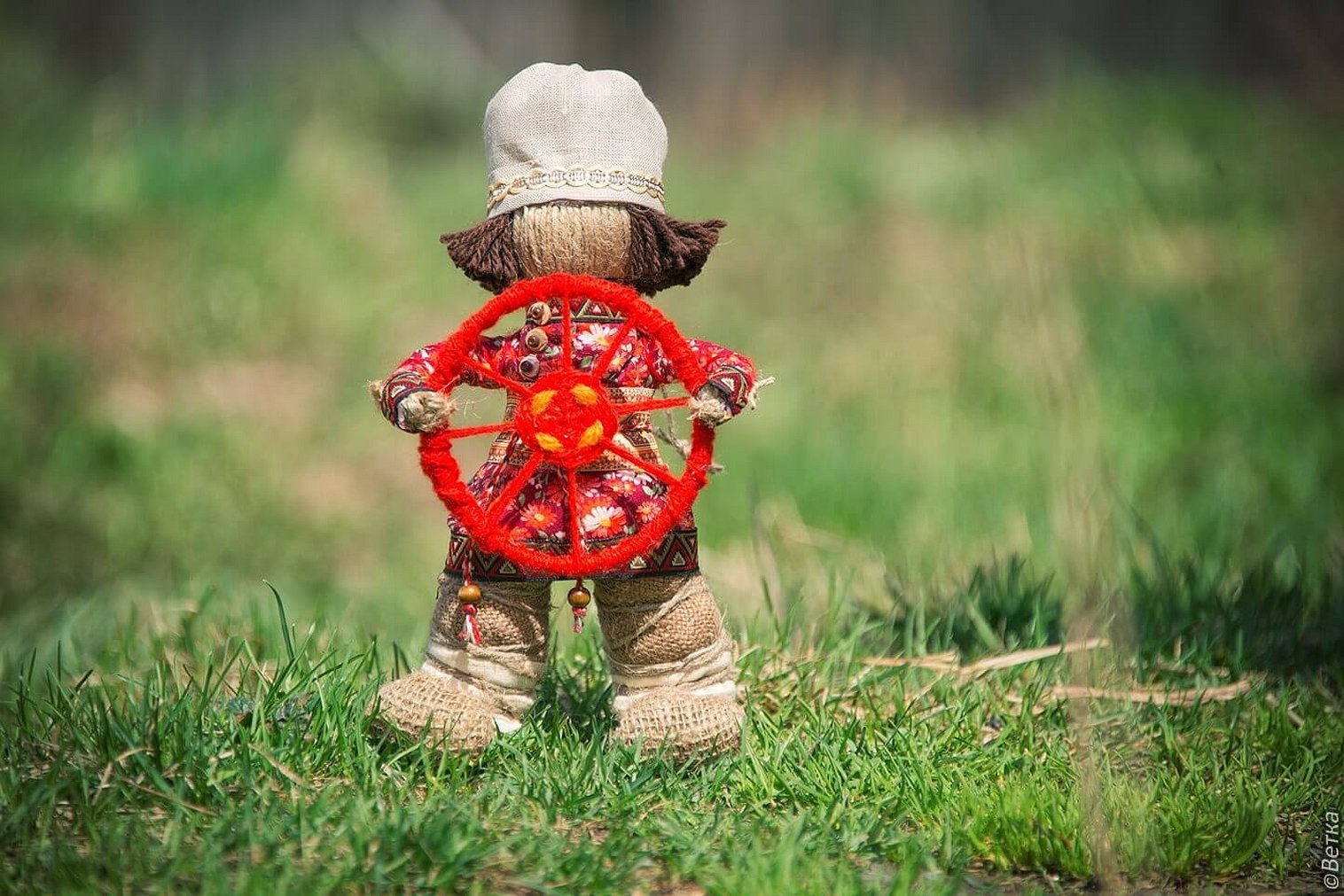
A rag doll was part of the everyday life of an ancient Russian person. Its presence in the family was given special significance. The doll, first of all:
- It was used in ritual activities. Special dolls were made for wedding ceremonies, funeral and mourning processions, for the birthday of a baby and for various pagan and later Christian holidays. As a rule, they did not have a face, but they had beautiful clothes that were changed depending on the occasion, and special filling. Thus, a doll stuffed with buckwheat grains was placed under the head of a newborn instead of a pillow, and a toy dressed in light skirts in winter was dressed in bright clothes in the spring - for the Maslenitsa holiday, decorating its head with ribbons and multi-colored rags.
- It symbolized the prosperity of the house and the skill of the women living under its roof. The first doll was given to the girl as soon as she stood on her feet and took her first steps. The mother taught her daughters not only to play with dolls, but also to understand their meaning, to sew suitable clothes. The girl was engaged in their sewing until her marriage. Her parents showed the toys to future matchmakers, demonstrating the skill and accuracy of their daughter. After the wedding, the collection of dolls was passed on to younger children, given away to acquaintances. But this was not the end of the acquaintance with the doll, now the wife sewed amulets for her family - children and husband.
- Protected the house. It was put in a prominent place to scare away evil spirits, given to a child for protection, to a woman preparing for an important event in her life, and taken with her on the road when moving.
Important! It was allowed to play with any kind of dolls, including those used as a talisman. Being pure and innocent creatures, children seemed to charge the talisman with warmth, energy and health.
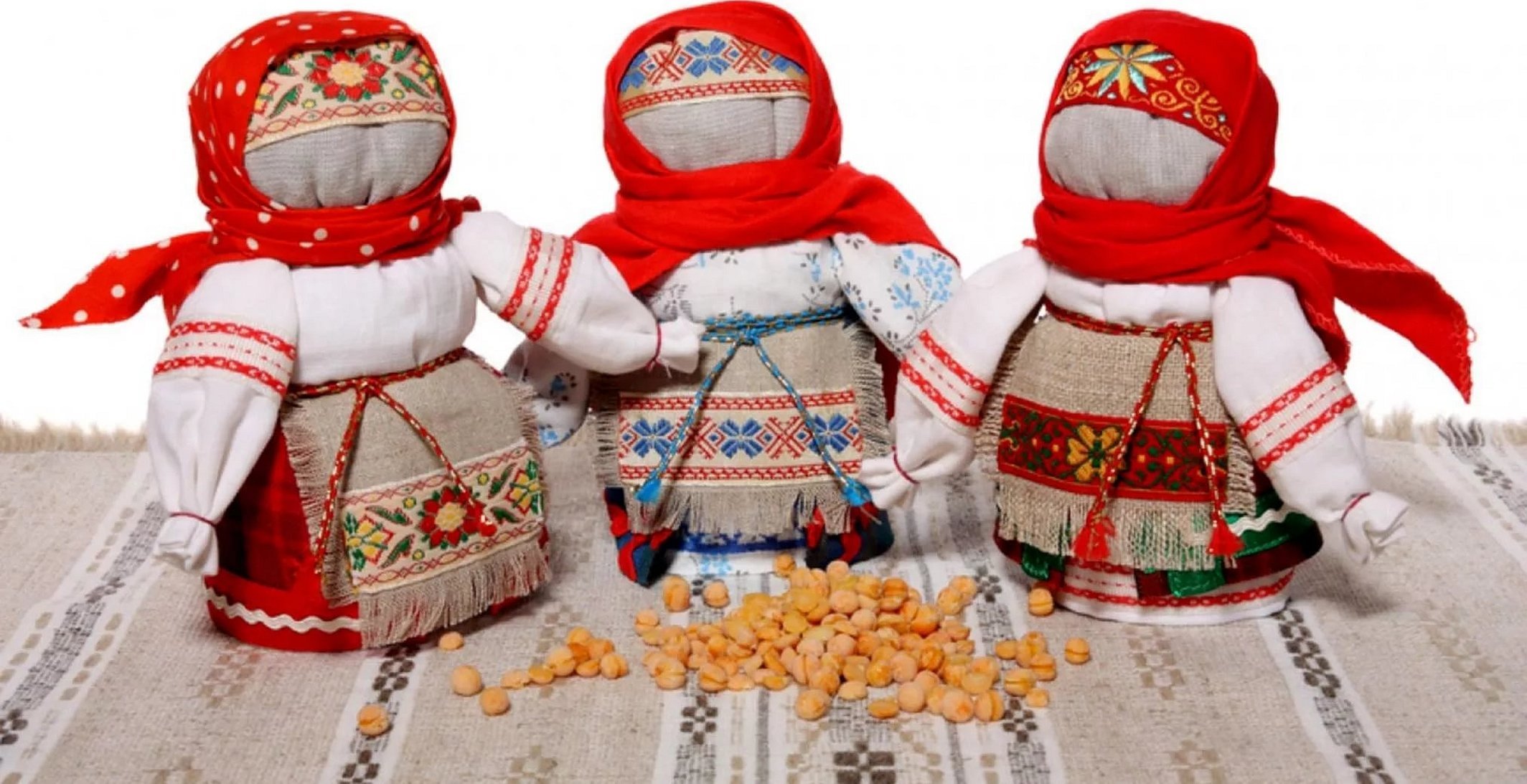
If a rag toy could not withstand active play and was damaged, it was not thrown away. The scattered grain filler was collected and stored until spring. As soon as the sowing season came, the grains were planted in the pasture for cattle. People believed that milk would become better from this, its quantity and quality would increase, and it would also become healing. In the fall, the doll was always filled with grains from the new harvest.
Features of Russian rag doll
For Russian folk dolls:
- There is no face, only an outline. It remains clean - no eyes, mouth or nose.
- There was no personal name - dolls were not called Masha, Nastasya or Katerina. This could harm the person whose name the toy bore, evil people could use it for their own purposes. If the name belonged to the spirit of a deceased relative, then it could be disturbed in this way, which would be undesirable. Toys were called dolls and trinkets. Ritual things were named according to their purpose - "wedding", "funeral", "vesnyanka" (a symbol of spring and awakening nature).
- There is a hidden "masculine" sacred meaning. Purely "masculine" dolls, embodying the image of a boy, a man, almost never existed. If they were made, then in the form of a stick wrapped in cloth, an angel with outstretched arms. But each "female" doll was made on a rigid frame of twisted sticks or cords. This is the hidden male essence.
Such a toy in 99% of cases embodied a female image. If it was planned to be used for a ritual, the toy was filled with peeled grains. There should not be anything sharp or cutting in such a doll. When making a toy:
- Scissors were not used, the fabric was torn from a large piece by hand;
- The clothes were fastened with knots and tied to the doll with threads; needles were also not used.
Any sharp object used in production could deprive the object of its semantic meaning. But Russian folk dolls, which were given for weddings, christenings, and other holidays, were usually sewn together, since they contained many decorative details: beads were not easy to tie to the fabric with simple threads without a needle.
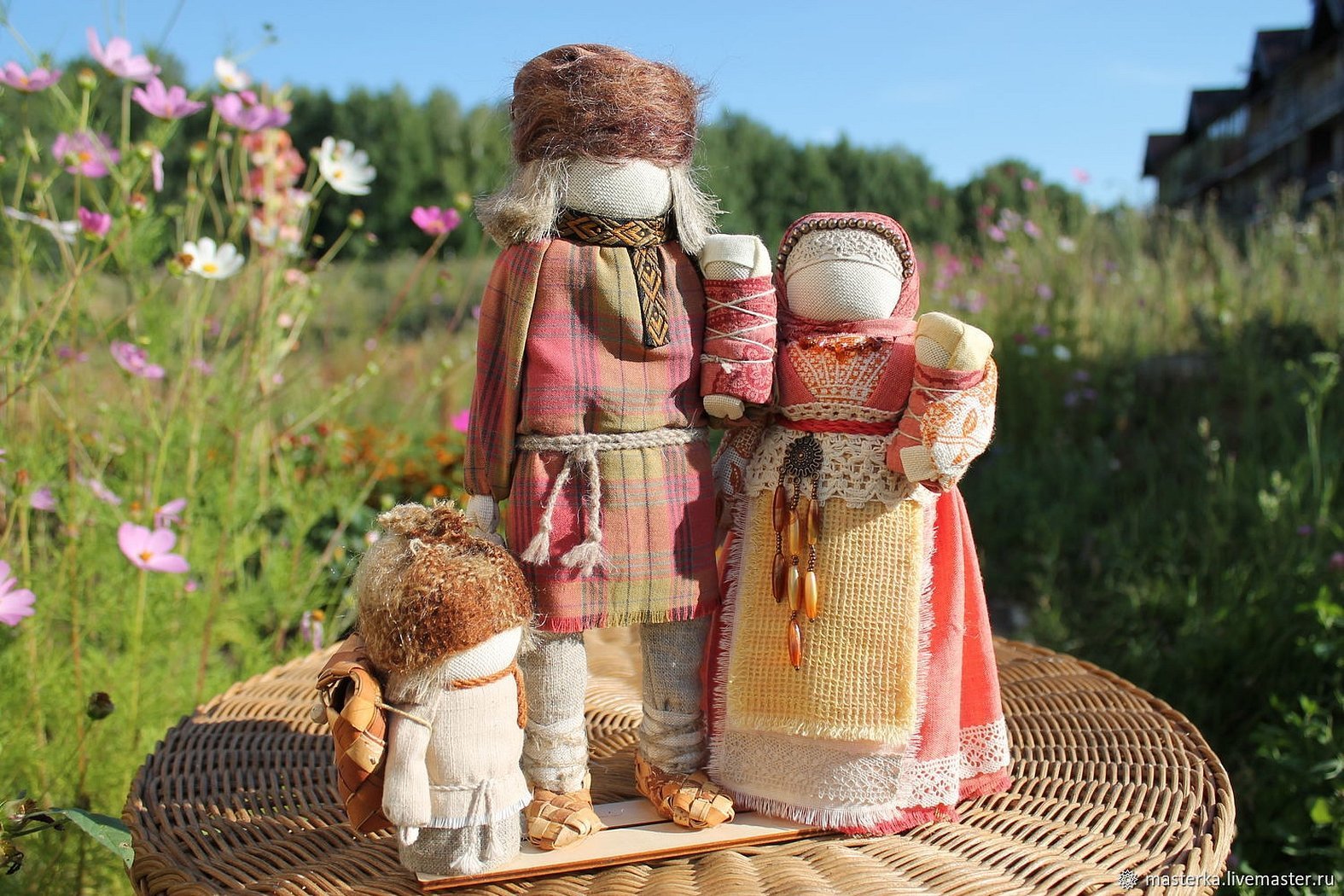
The absence of eyes, mouth and nose was associated with a reluctance to:
- To have extra eyes and ears in the house. Evil forces could penetrate the toy through the painted holes. In this case, it will cause the death of the entire family.
- Give the doll a character. If the face is unsuccessful, crooked or slanted, the character of the toy could be spoiled and this will affect the child who plays with it.
In the 19th century, rag toys began to have faces painted on them. In this simple way, they tried to humanize the toy as much as possible, to bring it closer to real conditions.
Please note! The dolls' faces were made as simple as possible, with two dots instead of eyes, a strip for the mouth, and the same strip for the nose. Ritual dolls still remained faceless.
Comparative Analysis of Different Types of Rag Dolls
The Slavs made several types of dolls in one category at the same time. For example, there were 4-8 varieties of amulet dolls alone, and even more of those used in various rituals and simply for games. Play dolls were supposed to keep the child busy while the parents were working or relaxing, and teach him to fulfill the social role assigned to him by society.
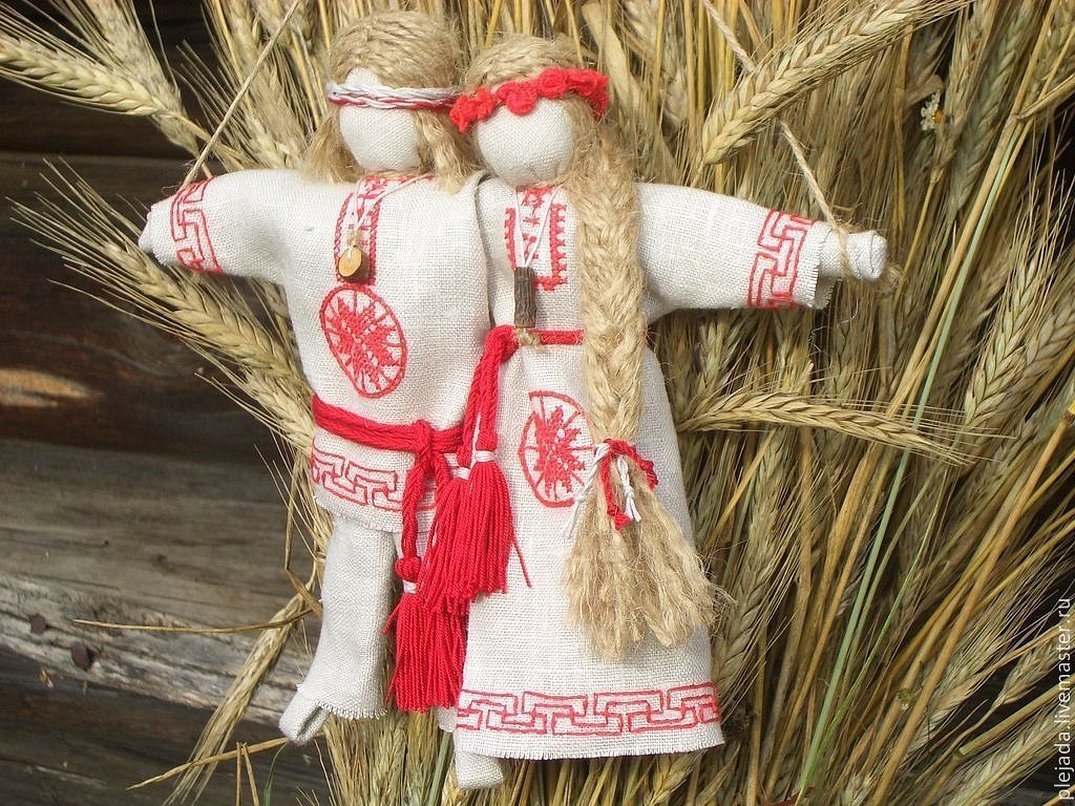
Both boys and girls took part in the games. The dolls that the boys played with sowed, plowed, looked after the cattle, built a house and chopped wood. Young men learned all this from their fathers and older brothers, and practiced on dolls. Girls learned to sew, to choose the right outfits for the whole family. Their toys cooked, washed floors, and raised children.
Please note! There was actually no big difference between play and ritual Slavic dolls, as well as protective dolls.
All national dolls had a rag body, in most cases filled with herbs or grains. They did not have faces painted on them. The difference could only be in clothing and the way they were used, and the toy could also be called differently:
- Traveler's toy. This toy was always put in a knapsack before a long journey. Its distinctive feature was a small bundle or bag filled with ashes taken from the hearth or grain. The ashes and the toy itself were the guarantee of the traveler's safe return home, and the grain was supposed to protect against need on the road, to relieve the traveler of troubles.
- Spiridon Solstice. It got its name from the holiday – December 22. One of the rare “male” dolls, depicted as a man with a large wheel in his hands, symbolizing the calendar year and the cycle of the sun. Spiridon is able to add strength to a person, help to change fate to his advantage. In Ancient Rus', Solstice was given to young men entering the period of adulthood.
- Happiness. A small girl in a bright dress and with a very long braid. According to the beliefs of ancestors, life force accumulates in hair. The doll helps to protect the owner from misfortunes. This is a purely female amulet, helping to preserve women's health and give birth to beautiful and strong children.
- Mokridina. This toy was made during drought to call for rain. Mokridina's dress was made of light fabric resembling raindrops.
- Kuvadka. It is also a ritual element. Kuvadka was made by the elder women in the family for the expectant mother. Its presence in the room of the expectant mother was considered mandatory. The doll protected the baby from evil forces and the evil eye.
- Fever. People made this toy to attract evil spirits. Once an evil spirit got into the doll, it could not leave it and was forced to stay in the toy until it was destroyed. Fever dolls were made 15-100 at a time and hung in a nook behind the stove. On January 15, after all the festivities were over, the dolls were taken off the strings or hooks and burned, and all evil left the house with them.
- Lovebirds. This amulet was made for family people. A lovebird is two dolls connected by one common hand. They were given as wedding gifts. After the birth of children in the family, colored ribbons were hung on the common hand according to the number of newborns.
- Herbalist's purse. According to surviving descriptions, the herbalist protected against diseases and was presented as a plump bag filled with medicinal herbs. Playing with the herbalist's purse, children and animals (cats, dogs) got rid of many diseases.
- Grain. Instead of herbs, the doll was filled with grain from the new harvest. The following year, during sowing, the grain was taken out of the doll and used to sow a plot of land in the field. The amulet was made to attract wealth to the house, preserve the harvested crop and increase the family's wealth. The grain was hung under the ceiling in the barn. A modern version of the doll can be placed in the kitchen, where it will be responsible for the safety of food.
Important! Any doll made of rags, made with your own hands, could be turned into a charm, a talisman, used for a ritual or given to children for games. The main thing is to treat it with care. Even with exclusively play dolls, children tried to handle it very carefully.

Materials for making a Russian rag doll
Toys and amulets were made by beginners and experienced craftsmen from improvised materials. These could be:
- scraps of fabric left over from sewing clothes;
- old clothes;
- new fabric (talismans and amulets were often made from fresh, recently woven fabric);
- bunches of grass, hay, straw and tree branches;
- wooden sticks;
- medium thickness paper;
- towels;
- logs.
The fabric was tightly rolled into a knot and the doll's body was made that way, or something like a bag was sewn, filling it with herbs, ash or grain. No pattern was made.
Traditional rag items in the Slavic style were mostly original, their image was not copied, each family came up with its own doll and outfit for it. Two identical toys or talismans were almost never found. Family dolls were especially honored, they were protected, passed from generation to generation. If such a doll was destroyed, they tried to quickly find a replacement for it, choosing similar materials or filling for them.
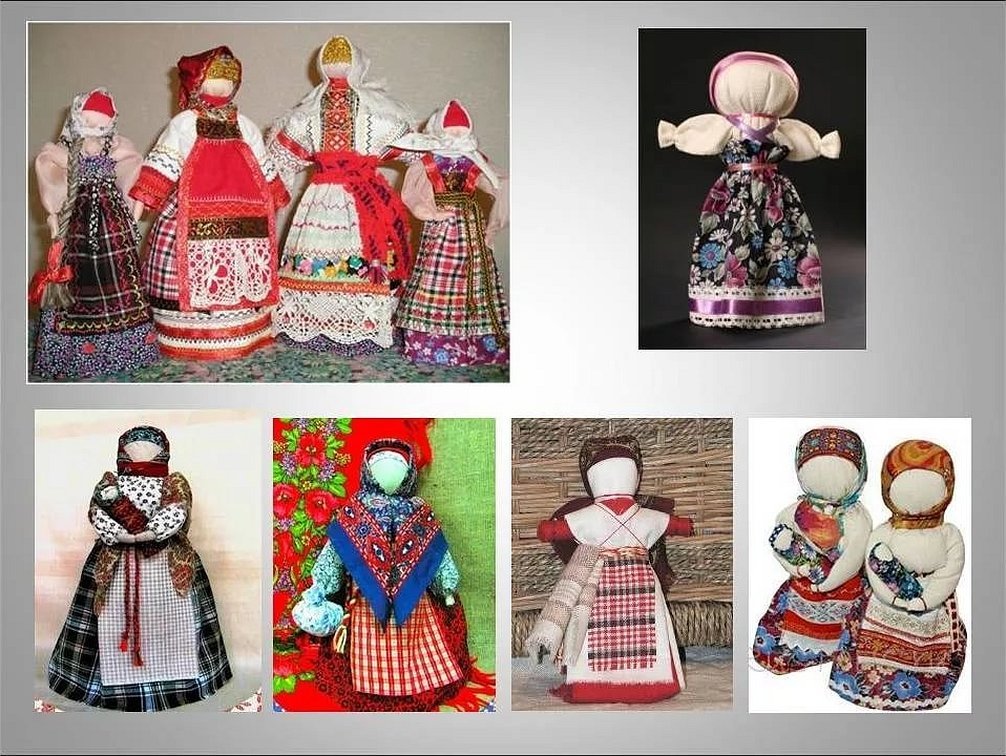
Manufacturing Features
According to the manufacturing method, the following types of folk dolls made of fabric can be distinguished, which can be made with your own hands:
- pole;
- cross;
- on a stick;
- nodal;
- diaper;
- twist;
- stuffed bag.
Most often, children's toys were twisted from fabric rolls and wrapped with scraps of fabric. Technologically, twisting the material into a roll is the simplest operation. But it has a deep mystical meaning. By creating a toy, people's ideas about the structure of the world, man and nature were conveyed. So, if they wound "in the direction of the sun" (clockwise), they sought to improve the current situation in the life that the creator of the amulet lived. When winding in the opposite direction, they sought to get to the other worlds in order to get answers to questions there. Dolls made in this way were used during fortune telling. To get a real ancient Russian rag doll, you need to:
- do everything slowly;
- avoid using scissors and needles when creating the body;
- secure the threads with a silk knot or loop;
- tear off the fabric of the dress so that fringe remains;
- make a protective cross out of threads on the doll’s chest or wind the threads exclusively clockwise;
- make sure that the number of threads during winding remains even and the number of tightenings remains odd;
Important! The doll's face, naturally, remains unpainted.
How to make a rag doll with your own hands
At school, during a labor lesson, the easiest way is to sew a Zernovushka (Zernushka) from rags. It will not only please children, but will also allow you to protect your home from evil, attract luck and wealth, and keep goodness in your pocket. A folk doll made with your own hands is made from:
- bleached calico and starched chintz;
- lace, ribbons, beads, embroidery threads;
- cereals or grains.
Working on a folk toy made with your own hands does not take much time. The step-by-step process of its production looks like this:
- A bag with gathering at the neck is sewn from the fabric.
- The bag must be filled with grain and the neck tightened.
- Step back about 5-10 cm (it all depends on the size), tie the bag with a thread. This is how the head is formed.
- The arms need to be made by rolling up pieces of calico and wrapping them with red threads. Sew them just below the base of the neck.
- Cover the head of the craft with a lace scarf, hiding the place where the seam joins. Embroider the lace with beads and ribbons.
- Sew the dress from any piece of fabric you like. It can be sewn or tied to the place where the body and head are connected. The style is invented independently.
The doll has no legs. The finished toy can be placed in a corner of the kitchen. Other types of antique dolls are made according to a similar principle, the main thing is not their appearance, but the meaning that the manufacturer gives to the thing he created. It is important to tune in to the right mood, to feel what kind of doll is needed, what it is for, what its role will be.
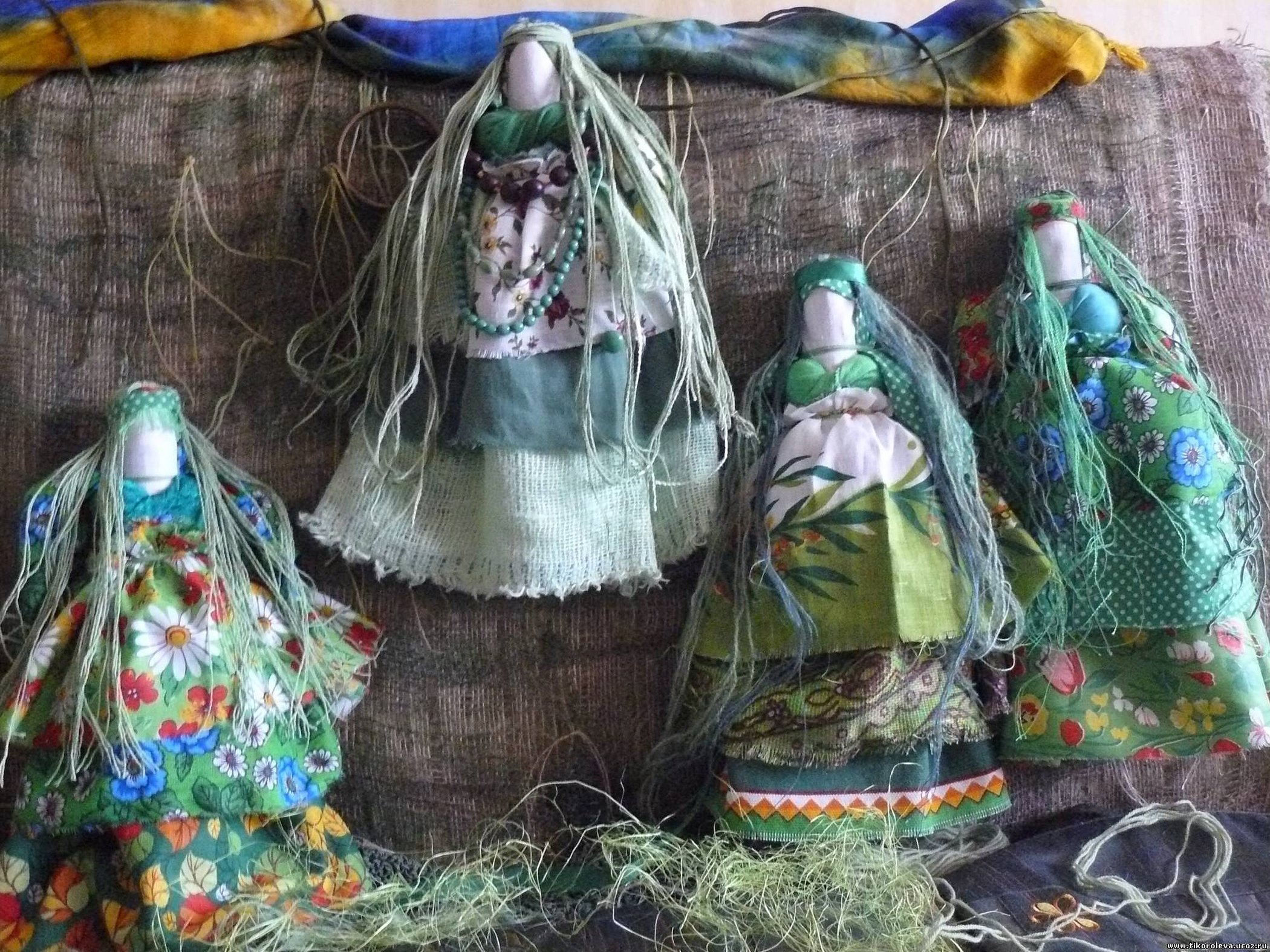
A rag doll is a toy, a talisman, and an attribute of religious rites. Girls were taught to sew it as soon as they could stand on their feet, it was a kind of suitability test. A future wife had to be able to sew, so as not to shed salty tears. Each toy had a practical and sacred meaning. From a practical point of view, it was supposed to help a small person in his development into an adult, and from a sacred point of view, it protected, gave health, attracted well-being, allowed a woman to give birth to a healthy child.

